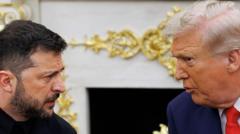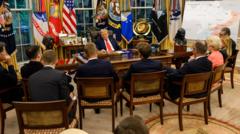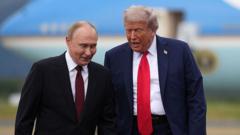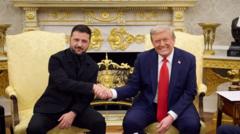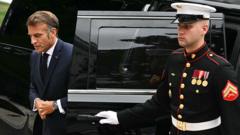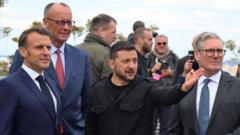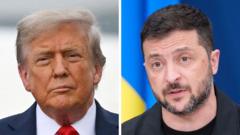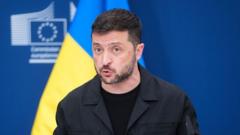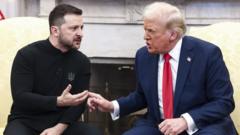Zelensky’s recent visit reflects diplomatic efforts to secure U.S. support while maintaining dialogue with Russia.
**Zelensky Engages in Diplomatic Maneuvering During Washington Visit**

**Zelensky Engages in Diplomatic Maneuvering During Washington Visit**
Ukrainian President's White House meeting fosters cautious optimism amidst ongoing conflicts.
Ukraine's President Volodymyr Zelensky's recent visit to the White House marks a significant moment in his ongoing efforts to secure international support as his country faces the continued Russian aggression. This meeting, in stark contrast to Zelensky's previous encounter with U.S. President Donald Trump earlier this year, showcased a determined effort by both leaders to adopt a more conciliatory tone, avoiding hostility despite substantive disagreements.
During their inaugural discussions in the Oval Office, Zelensky dressed with care, opting for a tailored collar suit, which Trump openly appreciated. The Ukrainian leader's initial reticence to engage deeply in conversation might have stemmed from apprehensions about diverging viewpoints with his host.
The meeting with Trump, however, took on a broader international dimension when the two leaders appeared alongside European heads of state, including German Chancellor Friedrich Merz and French President Emmanuel Macron. The joint statement emphasized a vision for a ceasefire in Ukraine, contrasting with Trump’s position that he deemed premature in the pursuit of a comprehensive resolution. Zelensky’s silence on the ceasefire issue during the appearance underscored the delicate balance he seeks to maintain amid the varying perspectives on how to conclude the conflict.
While details of their closed-door discussions were scarce, it appears that they centered on security guarantees for Ukraine and the prospects for a potential meeting between Zelensky and Russian President Vladimir Putin. Zelensky described these guarantees as critical to paving the way towards peace. He hinted at financial agreements that could involve significant U.S. military support, including a potential $90 billion deal for weaponry, alongside a collaboration on drone production.
Zelensky also indicated a willingness to engage in direct negotiations with Putin, extending an invitation for Trump to join those discussions if they come to fruition. Despite the lack of formal agreements, he emphasized a proactive stance on dialogue, asserting his commitment to the peace process and asserting that no firm date has been set for such meetings.
Significantly, Zelensky highlighted the extent of Russian occupation, asserting that they have captured less than 1% of Ukrainian territory over an extended period, a statement he claimed was new information to the Trump administration. This revelation appeared to resonate positively, lightening the atmosphere of their discussions.
Ultimately, the outcome of Zelensky’s meetings in Washington may not have immediately shifted geopolitical realities, but they created a window for diplomatic engagement and allowed Ukraine to navigate the political landscape with renewed momentum. As concerns about wider instability persist, both Zelensky and Trump demonstrated an understanding that maintaining dialogue remains crucial despite the ongoing conflict. Thus, while immediate resolutions elude, Zelensky’s visit successfully managed to extend the timeline for potential peace negotiations.

